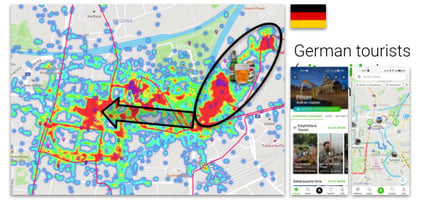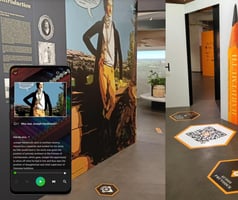The charm of popular tourist spots is often dimmed by overcrowding. Now more than ever, sustainable...
What are NFC tag stickers and how to use them in guiding tourists
The popularity and demand for Near Field Communication (NFC) stickers are noticeably increasing. These small, unpowered stickers work on a set of protocols enabling two devices within a certain distance (up to 4 cm) to interact. Their versatility, convenience, and compatibility with numerous smartphone devices make them an appealing choice for businesses and consumers. Despite the popularity of Quick Response (QR) codes, NFC tag stickers are emerging as a strong alternative in the tourism sector. One notable application is enhancing the functionality of an audio tour guide system. By tapping their device on an NFC sticker at a point of interest, visitors can receive relevant information, allowing for a more personalized and self-paced tour.

A tourist at a gallery using an NFC tag sticker to know more about the art.
In this blog post, we'll explore the exact and beneficial role of NFC tags in tourism, their comparison with QR codes, how these tags provide an edge over conventional point-of-interest descriptions, and their synergy with SmartGuide digital audio guide technology.
NFC stickers Vs. QR codes - A comparative study in tourism
When it comes to elevating the visitors’ exploration, especially around expositions, both NFC tag stickers and QR codes have become tipping points. Both technologies serve similar purposes by encoding information and delivering digital content. However, they differ significantly in terms of operation, benefits, and drawbacks.
NFC stickers are small tags with a microchip and antenna. They use near-field communication technology, programmed to perform specific actions when tapped by an NFC-enabled device. This secure feature prevents duplication, making NFC stickers popular. To use them, enable NFC in your device settings and tap the sticker with your phone.
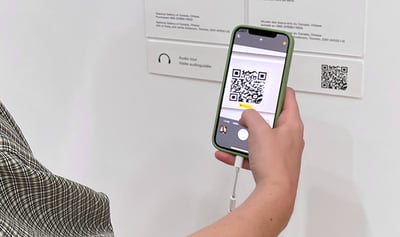
A visitor using a QR code at a tourist destination
Source: https://www.google.com/imgres
Advantages of NFC stickers:
- No need for smartphone cameras.
- More data transfer for exhibits (historical context, audio guides, augmented reality) compared to QR codes.
- Support of more secure data transfer - including contactless payments (unlike QR codes).
Drawbacks of NFC stickers:
- However, NFC stickers require an NFC-capable smartphone,
- Are generally more expensive, and
- Maybe less visually prominent than QR codes.
On the other hand, QR codes are 2D barcodes that can be scanned by a smartphone camera to access digital content such as websites or apps. They can direct users to specific sites with map locations, collect feedback, and reviews, and provide updated information about attractions or events. To use QR codes on smartphones, simply open the camera app, point it at the code, and tap the notification to open the associated link.
Advantages of QR codes:
- QR codes have advantages in visibility and flexible placement, making them easily spotted and scanned by tourists at expositions.
- They do not rely on NFC capabilities for information access and are cost-effective.
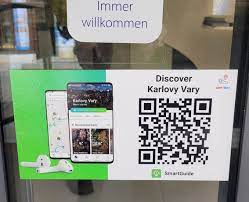
SmartGuide QR code at Karlovy Vary
Drawbacks of QR codes:
- The data transfer is limited compared to NFC stickers.
- QR codes require a smartphone camera for information access.
- They offer less security.
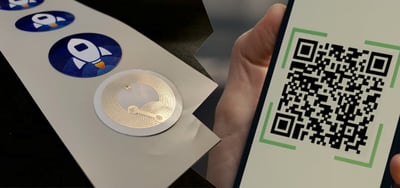
A tourist destination giving visitors the flexibility to use NFC stickers or QR codes
Source: https://www.asiarfid.com/
The choice between NFC stickers and QR codes depends on the specific requirements and preferences of the target audience. Both are used in tourism to provide relevant information, but each has its own strengths, limitations, and optimizations for different scenarios. Understanding these factors helps make an informed decision. Customization, branding, and security should also be considered when choosing between NFC tag stickers and QR codes.
How NFC tag stickers are a better choice than conventional point-of-interest descriptions?
Conventional point-of-interest descriptions, while effective, often face limitations. In response to these challenges, NFC tag stickers have emerged as a compelling alternative. These stickers hold several benefits over conventional point-of-interest descriptions, covering aspects such as:
- Improved user interaction: NFC stickers simplify device interaction, enabling seamless data sharing. This enhances convenience and efficiency, paving the way for a smoother user experience.
- Durability: NFC tags are designed to withstand various environments, including extreme weather conditions and exposure to chemicals. Their durability ensures reliable performance over time.
- Branding prospects: NFC stickers allow tourist attractions and travel businesses to create unique custom stickers with logos and relevant information.
- Expanded content delivery: Physical signs, brochures, or pamphlets have limited space for information, which can result in an incomplete tourist experience. In contrast, NFC stickers can store ample data, providing a more detailed content delivery mechanism.
- Strong security: NFC technology utilizes encryption to enhance data security, surpassing conventional point-of-interest descriptions. It can also quickly detect forged documents and fraudsters, reducing the risk of unauthorized access to systems.
NFC stickers offer a multitude of benefits over conventional point-of-interest descriptions. All these features justify the higher cost of NFC tags. By leveraging these advantages, travel businesses can significantly augment their operations, stand out in competitive markets, deliver more comprehensive information, and bolster their security measures. Therefore, the adoption of NFC technology could be a strategic move in the tourism industry to stay ahead in the digital era.
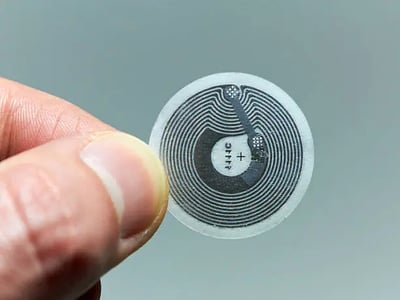
This is what NFC stickers look like!
Source: https://www.indiamart.com/
How to use NFC stickers when navigating an exposition with SmartGuide?
NFC (Near Field Communication) stickers are easy to use and can be programmed for specific tasks. Here is a step-by-step guide on how to use NFC stickers with SmartGuide's audio guides:
- Obtain an NFC-capable smartphone.
- On the smartphone, go into settings and ensure NFC is turned on. This setting is usually found under 'Wireless & Networks' or ‘Connected Devices’ on Android and in the 'Control Center' on iPhones.
- Download the SmartGuide app from the Google Play Store or Apple App Store. Install and open the app.
- Find the NFC stickers at the location. It could be placed near an exhibit, landmark, or point of interest.
- Hold the top-back part of the smartphone (where the NFC chip is usually located) near the NFC sticker. The distance should be about 4 cm or less.
- Once the smartphone detects the NFC sticker, it will automatically open the corresponding audio guide in the SmartGuide app. If it doesn't open automatically, check the smartphone's settings to ensure it's set to read NFC tags.
- Put on headphones or use the smartphone's speaker to listen to the audio guide.
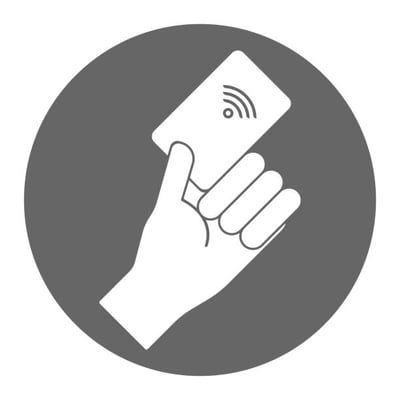
Helping travel businesses overcome potential challenges with the implementation of SmartGuide NFC stickers
While NFC stickers offer several advantages, tourist attractions, and travel businesses may encounter challenges when implementing them, such as understanding how to program them and where/how to place these tags (since they should be placed in high-traffic areas and points of interest).
SmartGuide provides pre-programmed NFC tags with general content, available for further customization. Furthermore, with its proficiency in travel and technology, SmartGuide identifies the best locations for tag placement, thanks to its big data dashboards and GPS heatmaps, which offer critical data analytics insights.
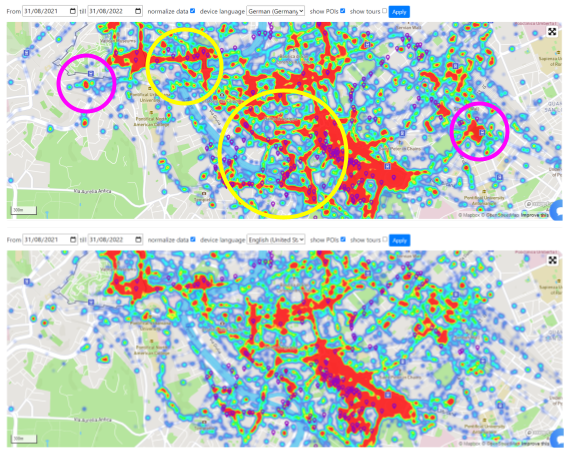
GPS heatmaps on SmartGuide CMS
SmartGuide, an audio tour guide app platform, enables the addition of NFC stickers to any point of interest (POI) label or object.
Conclusion
NFC tags and NFC stickers are powerful tools for digital communication, enabling seamless data transfer and task execution. They help enhance visitor interactions at tourist sites, especially at expositions where platforms like SmartGuide leverage them to offer interactive content at points of interest. However, their effectiveness depends on the target audience's needs and use scenarios.
While high-traffic areas or travel businesses seeking interactive engagements may find them invaluable, their benefits may be less evident in situations where digital interaction isn't a priority. Therefore, understanding these nuances is crucial for optimizing the use of NFC stickers, allowing for customized programming and strategic placement to maximize their strengths.
Interested in exploring the potential of NFC tag stickers for your tourist attraction or travel business? Contact us today.
.png?width=300&height=69&name=Logo%20SmartGuide%20horizontal%20(1).png)
